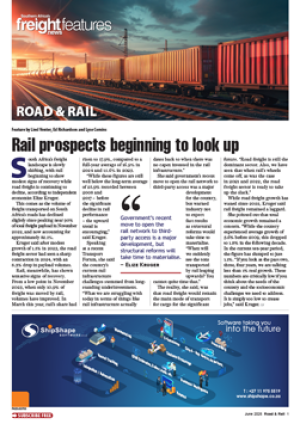Lines desperate for rates increase following demise of Secil Sul
DESPITE NEWS of one of the shipping lines operating the Angola run closing its doors (Secil Sul), the trade is still measured as buoyant (in increasing volumes) by the players on this sea route.
Noel Barry - who heads up Safmarine's agency for CMBT's West African trade - suggests that the current volume of trade is running at around 5 500 TEUs (twenty foot equivalent units) a year into the Angolan capital of Luanda, and about 100 000 tons of breakbulk cargo.
It's very buoyant at the moment, he said. But things can change overnight.
And his uncertainty, he claims, is not just a burst of pessimism on his part, but supported by previous events. This has happened in the past, he told FTW, when letters of credit were suddenly not available, or the Angolan government slapped a restriction on import permits.
But SA exporters are currently making hay while the sun shines.
According to Catherine Harris, Angola trade controller at Grindrod's Africalink, keeping up with the demand of the moment is hard work.
Volumes are increasing rapidly, she said. We are heavily involved in moving all sorts of perishables to Angola - a country which is almost a complete importer of its food needs.
The likes of potatoes, onions, flour, maize, fruit juice and fresh fruit, and long-life milk - all the basics - are in such demand that we can hardly get consignments in quickly enough. We are presently looking to increase these volumes.
Both Harris and Barry also point to machinery and industrial capital equipment exports to Angola being on the rise, with quite a bit of return traffic in oil production equipment.
Barry defines the most noticeable cargoes on CMBT's manifests as: Foodstuffs, perishables, soft drinks, detergents and soaps, motor vehicles, iron and steel products and machinery.
But - given these enthusiastic reports about increasing volumes - why has a shipping line collapsed?
The problem, Mark Kilbride of Meihuizen Freight (agents for the Angola South Line) told FTW a year ago: Is over-capacity and very low rates.
And he's sticking to the same story this year.
The big boys - CMBT, Lloyd Triestino, Mitsui OSK and P&O Nedlloyd - all serve the port of Luanda with big ships, large available capacity, and low rates.
These rates are continually being cut, according to Harris, and - if any lesson is to be learned from the demise of Secil Sul - it is that only the biggies can keep this going, she told FTW.
But they're not in any sort of rates war, according to Barry. When we started out, he said, SA companies hadn't had much to do with West Africa (because of the sanctions, and the fact that French and Portugese sources were historically preferred). We didn't know what the rates should be.
The rates have run down, but did not decrease substantially last year, and I would say they have now bottomed out.
But a rates increase is really what's needed, according to Harris, or soon only the big players will be left.
Kilbride agrees. His line is busy keeping out of the way of the big boys, niche marketing to the smaller ports where the large ships can't call. But the export market is still looking for the low rates it is now used to. At the same time, Kilbride said, we've got smaller ships, and less volume. We're getting by - able to run two vessels at the moment - but it's not a good situation.
Barry suggests that there's another problem for these small - mostly breakbulk carrying - lines.
CMBT is looking for mostly containerised cargoes to Luanda, he said, where delays could be up to two-to-three weeks for breakbulk, but where containers aren't too bad.
But for the breakbulk carriers - especially to the smaller ports - the delays are a big worry. They could be sitting around at anchor waiting for a berth for over a week. If your ship is costing you around US$5 000 a day, these waits can be very damaging, said Barry.
Add to that no storage at the smaller harbours, a need for road vehicles to meet the ship, and a lousy road system in Angola, and the problem becomes worse. And even worse if you take into account the high pilferage rate in Angola.
If you are going to move breakbulk you have to be very careful just WHAT cargoes you accept, said Barry. You have to analyse what cargoes you take - those which will be profitable for you in the end.
The presumption from all of this is that Secil Sul got caught by all the problems - and was just unable to survive these adverse conditions.
It is, therefore, a tough sea trade. And only the fittest are likely to survive, said Harris.
